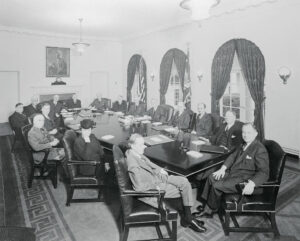The Cabinet: Advisers to the President
The various departments of the executive branch help run the country, and their heads report directly to the president.
By: Jose Backer | November 19, 2020 | 491 Words

President George W. Bush speaks during a meeting with his cabinet (Photo by Ron Sachs-Pool/Getty Images)
As the head of the executive branch, the president must enforce legislation and, in some cases, Supreme Court decisions favorable to their administration. To meet the office’s demands, hundreds of federal agencies and departments have been created during the many presidential administrations in American history. Although the president sits at the top of the executive branch, a group of presidential advisers called the Cabinet takes responsibility for the various offices and departments that keep the country running daily.
The Cabinet of the United States originally consisted of the vice president, attorney general, the secretary of state, the secretary of treasury, and the secretary of war – which was later renamed secretary of defense. Over the years, many new departments – and therefore Cabinet positions – have been added. The full Cabinet now includes the following departments: Interior, Agriculture, Commerce, Labor, Health and Human Services, Housing and Urban Development, Transportation, Energy, Education, Veterans Affairs, and Homeland Security.
Each Cabinet member is the head of his or her department, and each department is in charge of a different segment of the federal government. For example, the Department of the Treasury prints money, collects taxes, manages the national debt, and supervises banks throughout the country. The Department of Justice, headed by the attorney general, is in charge of enforcing federal laws and prosecuting those who violate them. It includes various federal law enforcement agencies, like the FBI, the ATF, and the DEA, as well as a great number of attorneys.

President Roosevelt seated with his “war cabinet,” which consists of his regular Cabinet in addition to the heads of the nation’s principal administrative bureaus. (Getty Images)
Cabinet positions represent the way presidents have maintained and exerted control over the executive branch of the federal government. These positions are often used to make statements on a presidential administration’s goals for the next four years. President Clinton’s Cabinet was filled with many women, a first for presidential administrations that typically did not include women at the highest positions of power that was meant to represent “a Cabinet that looked like America.” President Obama’s Cabinet was important, but the president also had many “czars” or policy experts that would advise him separately on issues that were often very different from advice that came from his Cabinet. President George W. Bush had one of the most powerful Cabinet members in executive branch history. His vice president, Dick Cheney, influenced domestic and international policy so significantly that many consider him the most powerful vice president in American history.
It is important to note that while the Cabinet is mighty and helps manage the country, the president ultimately holds power in the executive branch. A president will not willingly pick a Cabinet that opposes his real legislative plan, even if their public statements say otherwise. While bureaucrats are extremely powerful nowadays, they still answer to the president at the end of the day.
















